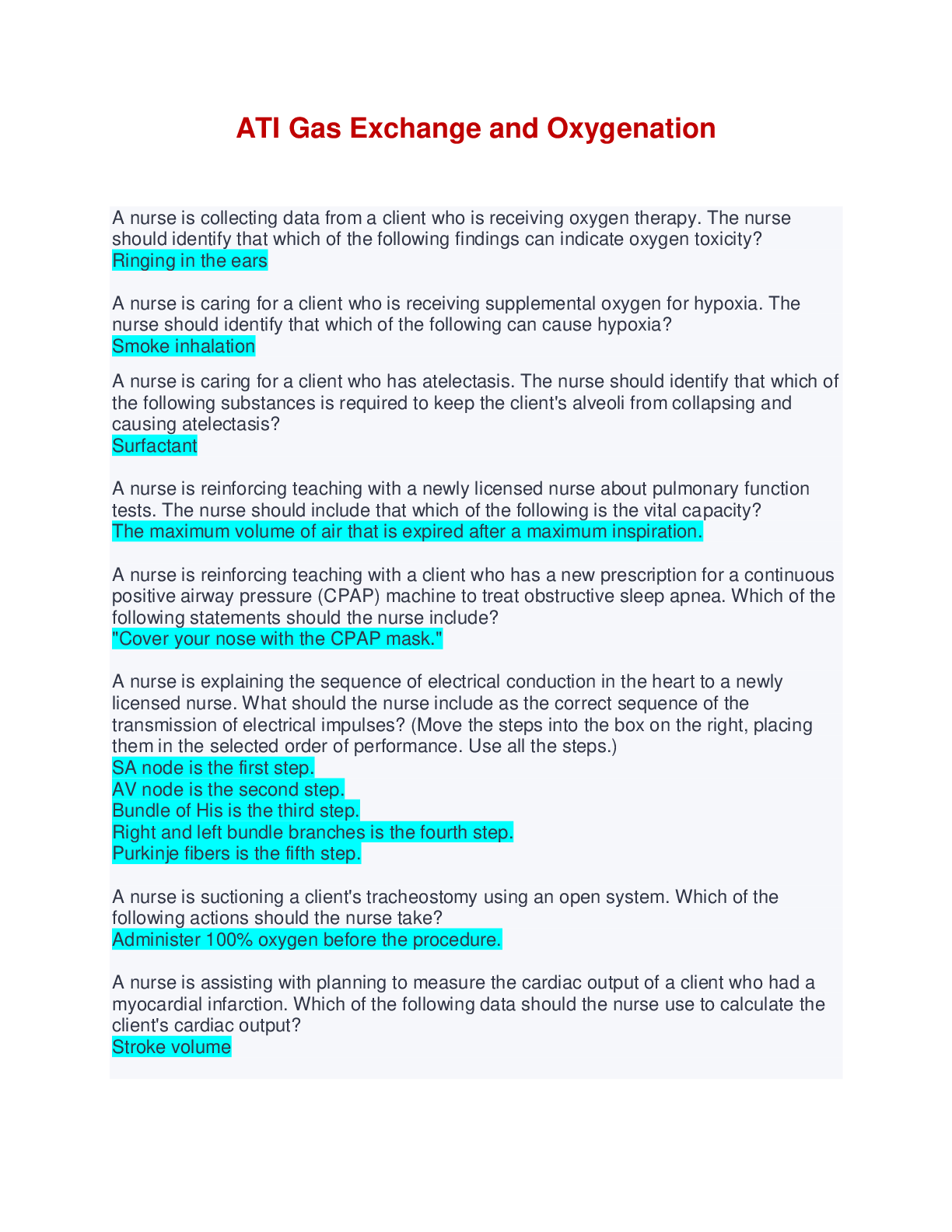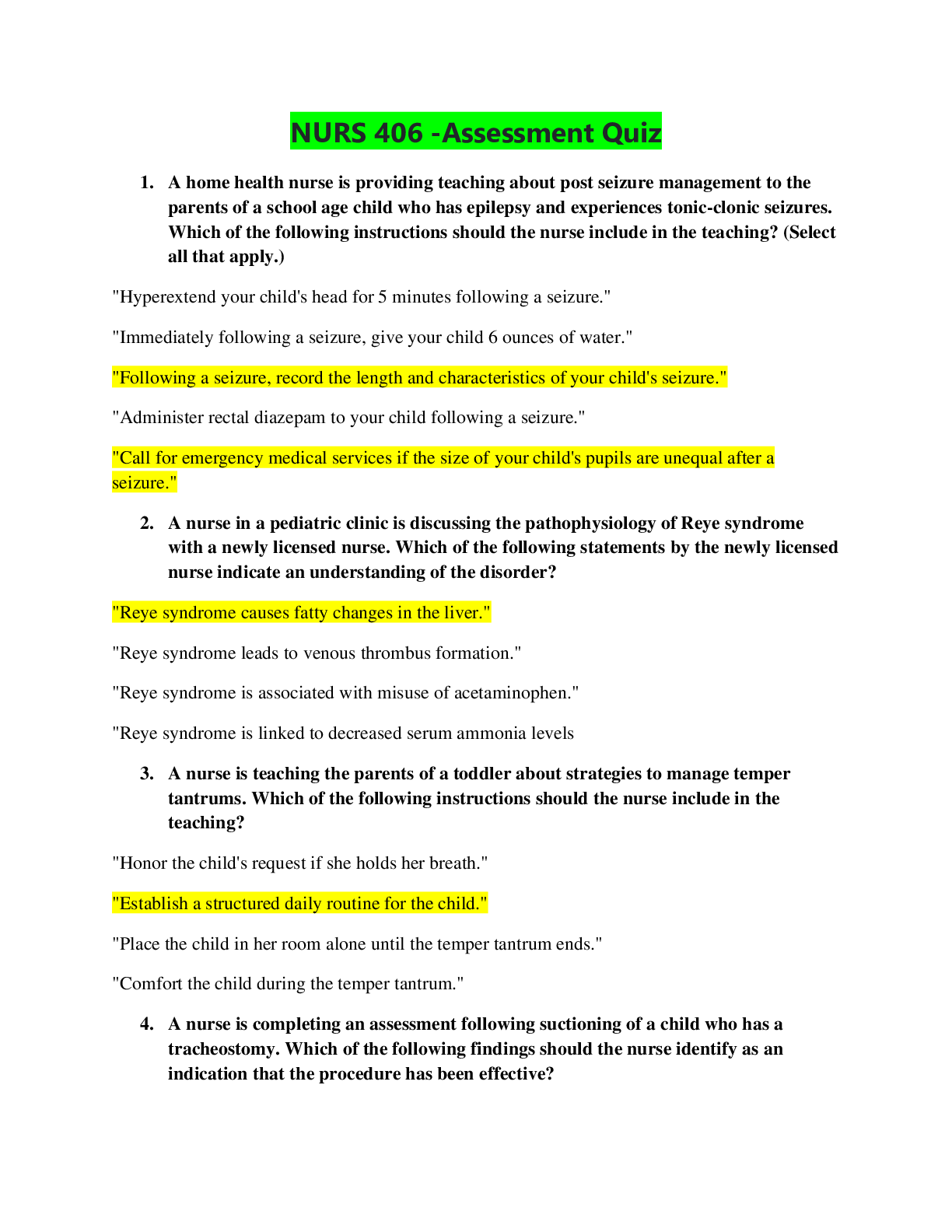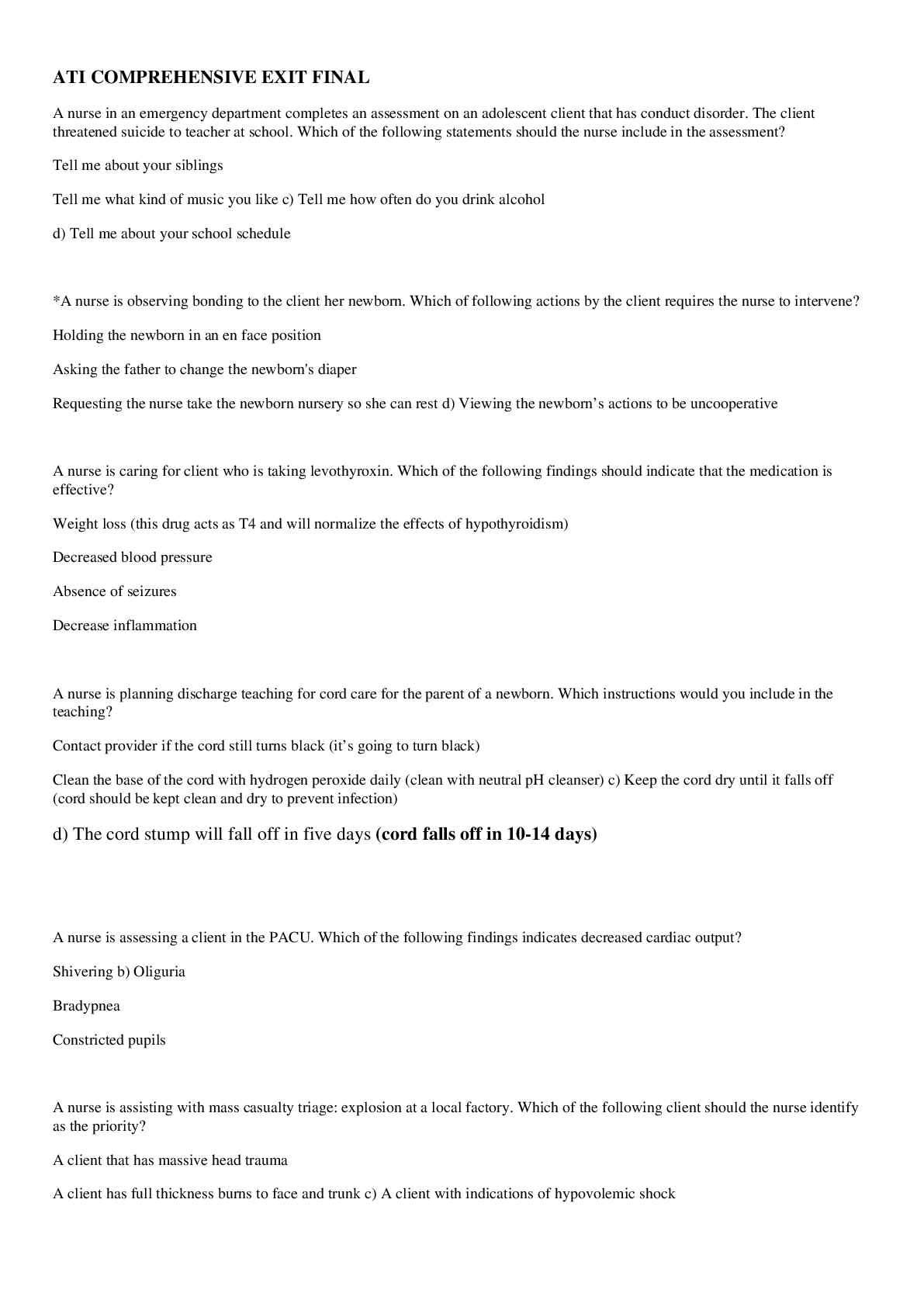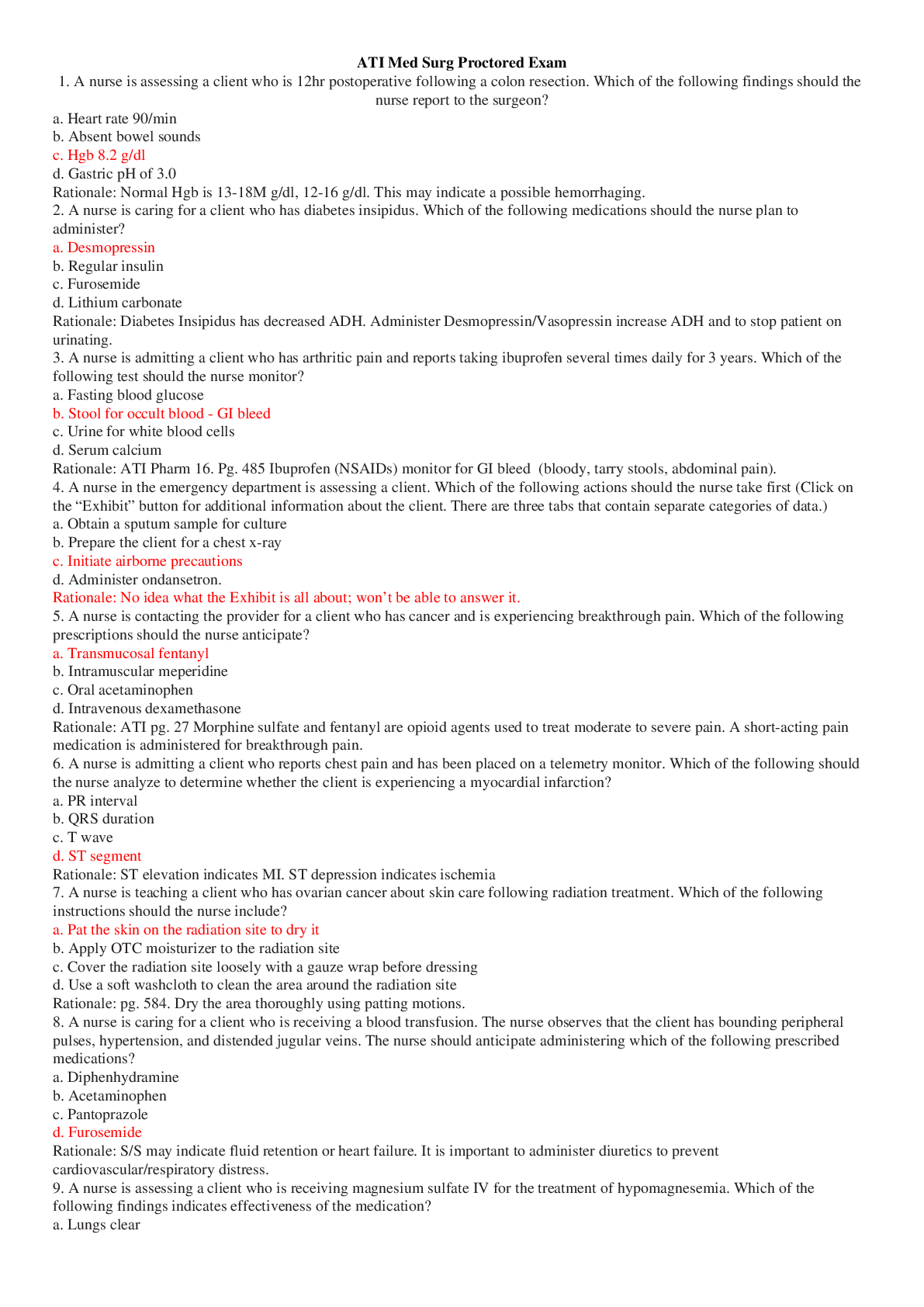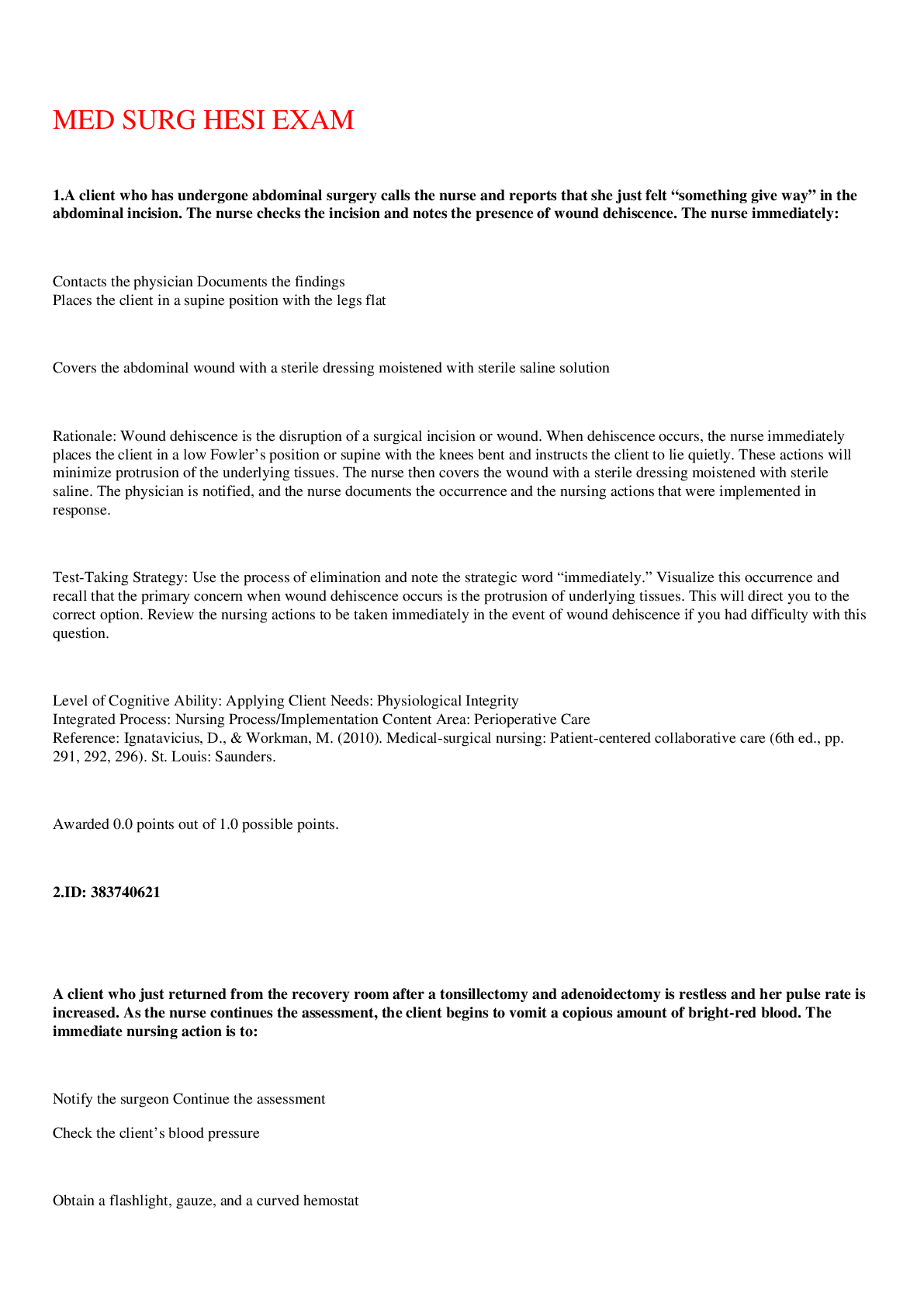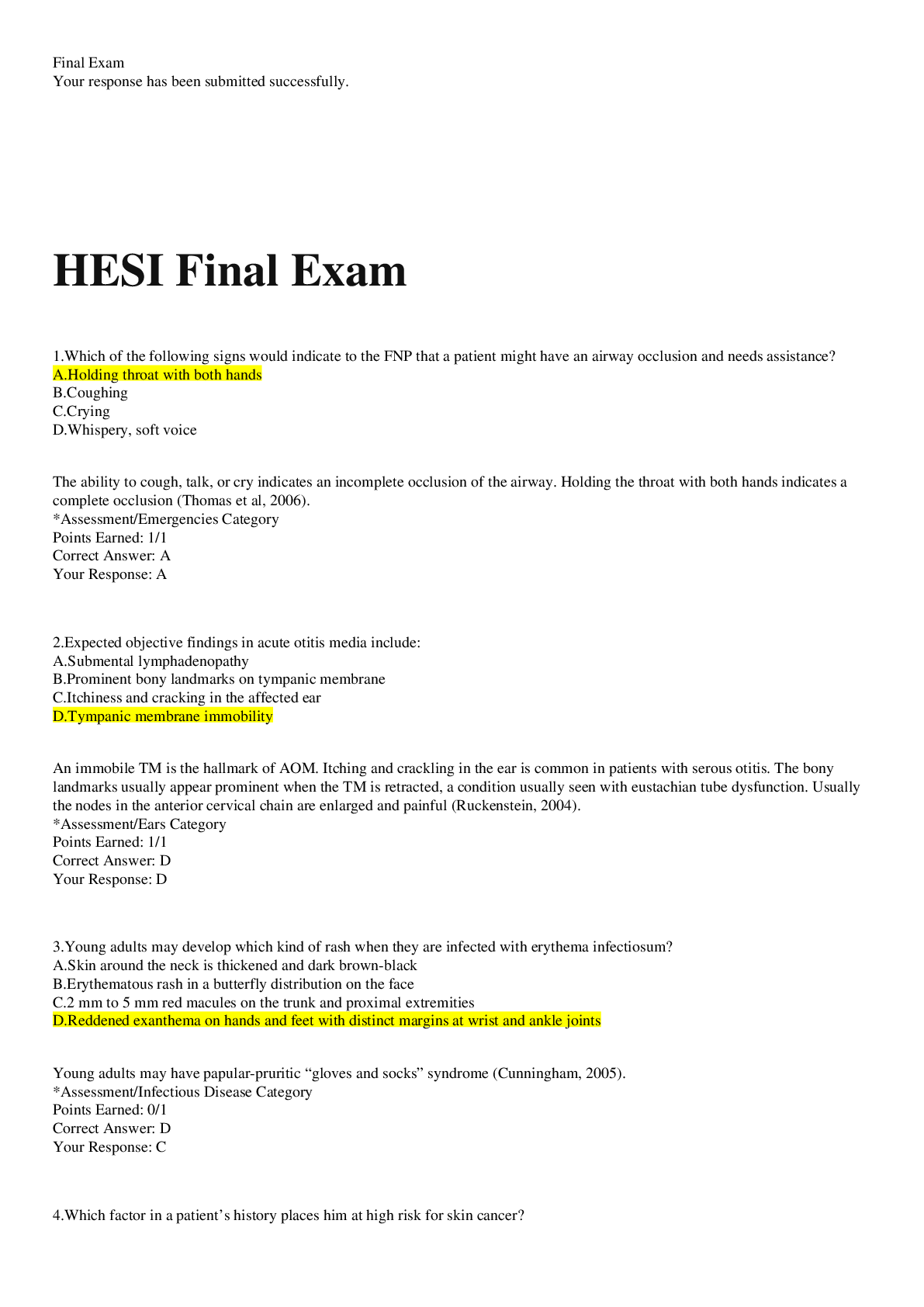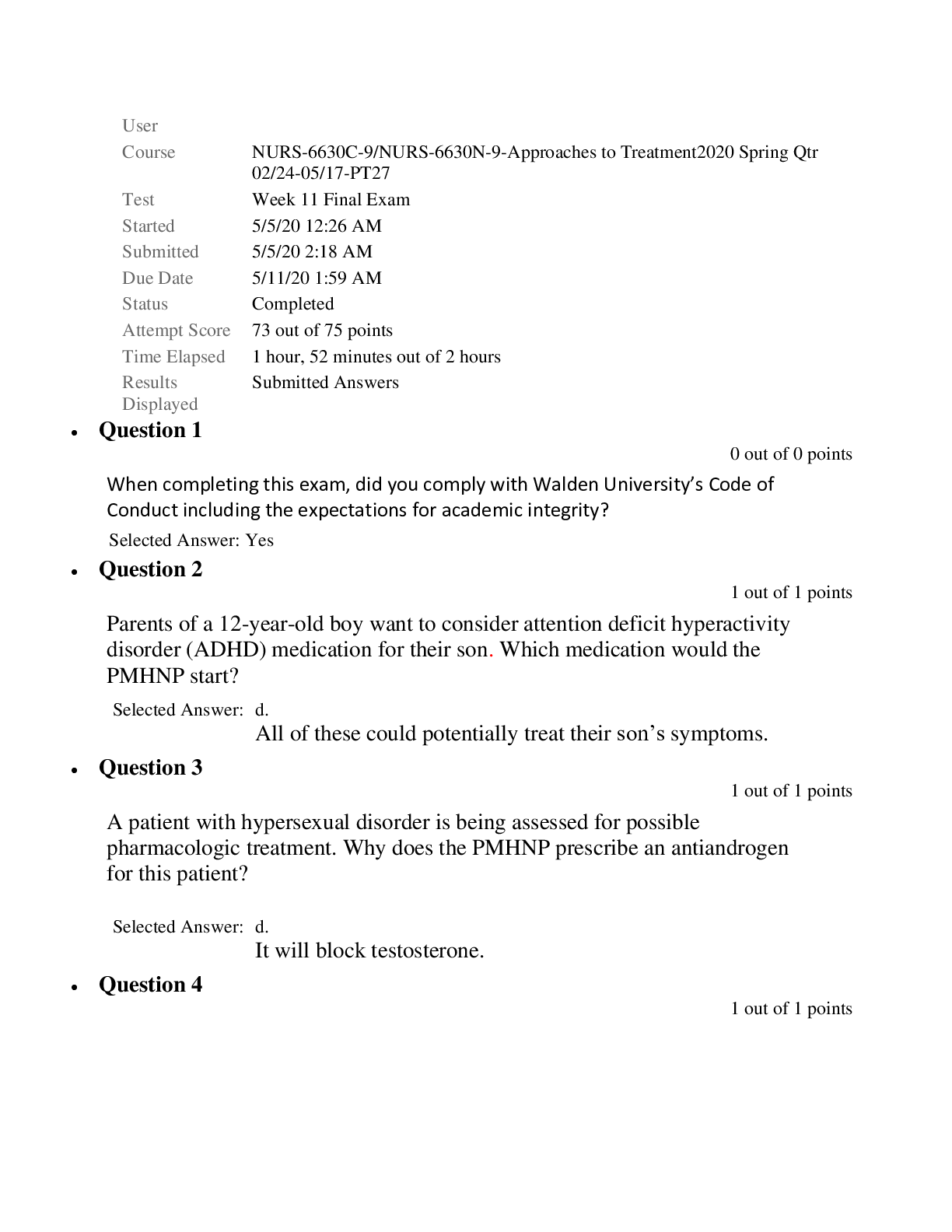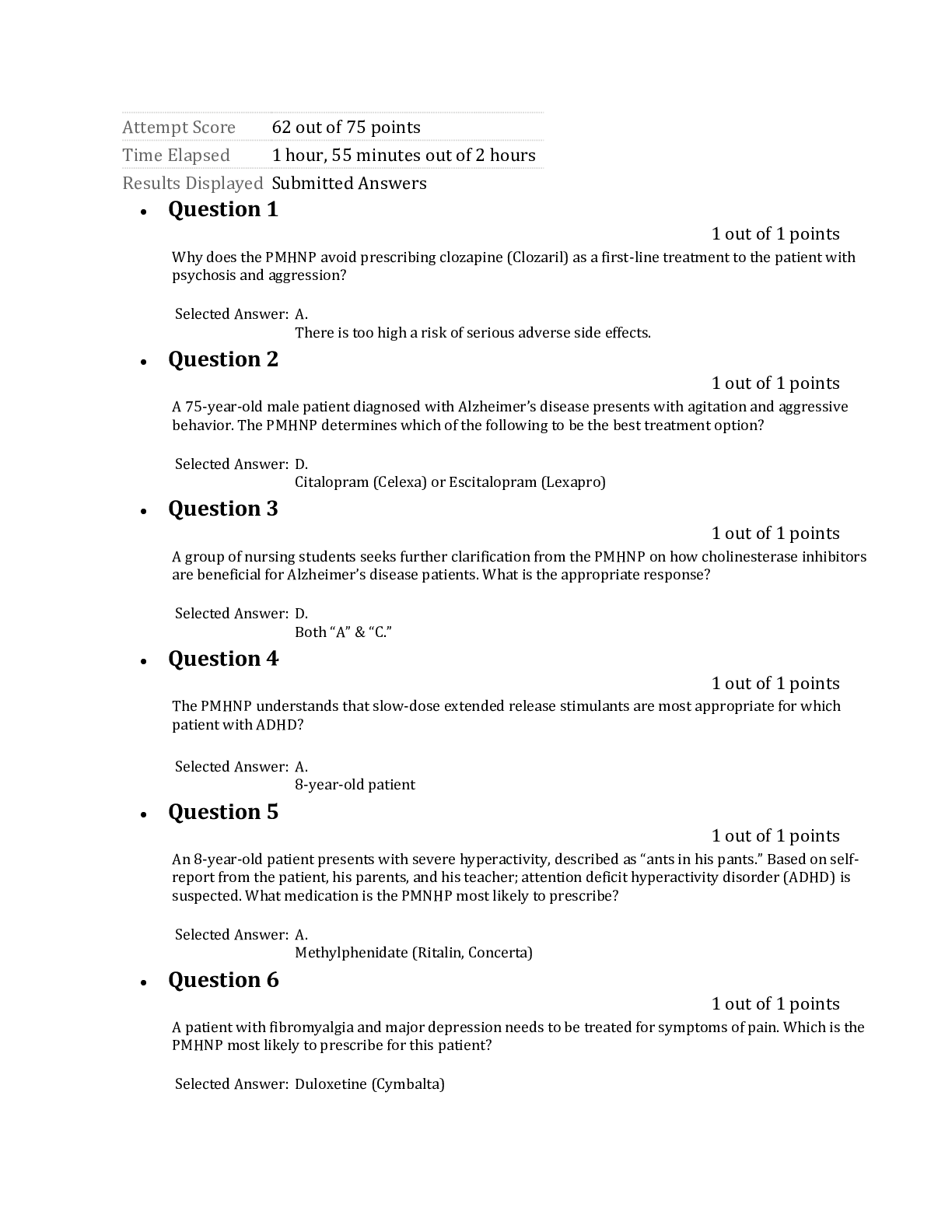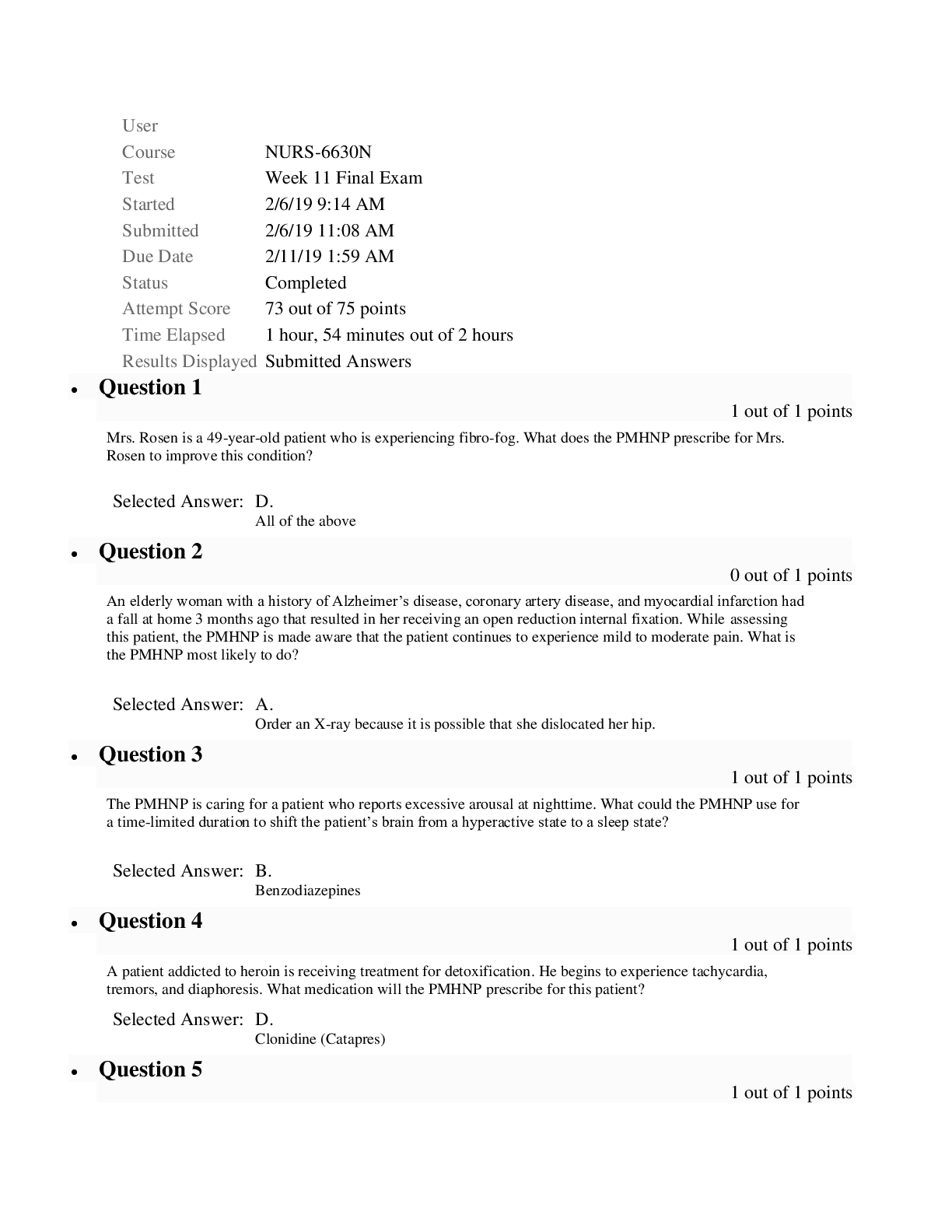NURSING 2362 - Module 8 Exam (Questions and Answers)
Document Content and Description Below
Module 8 Exam (Questions and Answers)Questions 1. ID: 8482576270A nurse notes that the site of a client’s peripheral intravenous (IV) catheter is reddened, warm, painful, and slightly edematous nea... r the insertion point of the catheter. On the basis of this assessment, the nurse first: Removes the IV catheter Correct Slows the rate of infusion Notifies the healthcare provider Checks for loose catheter connections Rationale: Phlebitis is an inflammatory process in the vein. Phlebitis at an IV site may be indicated by client discomfort at the site or by redness, warmth, and swelling in the area of the catheter. The IV catheter should be removed and a new IV line inserted at a different site. Slowing the rate of infusion and checking for loose catheter connections are not correct responses. The healthcare provider would be notified if phlebitis were to occur, but this is not the initial action. Test-Taking Strategy: Use the process of elimination, focusing on the data in the question. Eliminate slowing the rate of infusion and checking the connection, because they are comparable or alike in that they indicate continuation of IV therapy. Although the healthcare provider would be notified of this occurrence, the word “first” should direct you to select the option of removing the IV catheter. Review the signs of phlebitis and the actions to be taken when it occurs if you had difficulty with this question. Level of Cognitive Ability: Applying Client Needs: Physiological Integrity Integrated Process: Nursing Process/Implementation Content Area: Intravenous Therapy Reference: Ignatavicius, D., & Workman, M. (2010). Medical-surgical nursing: Patient-centered collaborative care (6th ed., p. 227). St. Louis: Saunders. Awarded 1.0 points out of 1.0 possible points. 2. ID: 8482578714A nurse hangs a 500-mL bag of intravenous (IV) fluid for an assigned client. One hour later the client complains of chest tightness, is dyspneic and apprehensive, and has an irregular pulse. The IV bag has 100 mL remaining. Which of the following actions should the nurse take first? Removing the IV Sitting the client up in bed Shutting off the IV infusion Correct Slowing the rate of infusion Rationale: The client’s symptoms are indicative of speed shock, which results from the rapid infusion of drugs or a bolus infusion. In this case, the nurse would note that 400 mL has infused over 60 minutes. The first action on the part of the nurse is shutting off the IV infusion. Other actions may follow in rapid sequence: The nurse may elevate the head of the bed to aid the client’s breathing and then immediately notify the healthcare provider. Slowing the infusion rate is inappropriate because the client will continue to receive fluid. The IV does not need to be removed. It may be needed to manage the complication. Test-Taking Strategy: Use the process of elimination, focusing on the data in the question. Note the question contains the strategic word “first.” Recognizing the signs of speed shock and recalling the appropriate interventions should also direct you to the option of shutting off the IV infusion. Review the initial nursing actions for speed shock if you had difficulty with this question. Level of Cognitive Ability: Applying Client Needs: Physiological Integrity Integrated Process: Nursing Process/Implementation Content Area: Intravenous Therapy Reference: Ignatavicius, D., & Workman, M. (2010). Medical-surgical nursing: Patient-centered collaborative care (6th ed., p. 230). St. Louis: Saunders. Awarded 1.0 points out of 1.0 possible points. 3. ID: 8482574309A nurse discontinues infusion of a unit of packed red blood cells (RBCs) because the client is experiencing a transfusion reaction. After discontinuing the transfusion, which of the following actions does the nurse take next? Removing the IV catheter Contacting the healthcare provider Correct Changing the solution to 5% dextrose in water Obtaining a culture of the tip of the catheter device removed from the client Rationale: If the nurse suspects a transfusion reaction, the transfusion is stopped and normal saline solution infused at a keep-vein-open rate pending further physician prescriptions. The nurse then contacts the physician. Dextrose in water is not used, because it may cause clotting or hemolysis of blood cells. Normal saline solution is the only type of IV fluid that is compatible with blood. The nurse would not remove the IV catheter, because then there would be no IV access route through which to treat the reaction. There is no reason to obtain a culture of the catheter tip; this is done when an infection is suspected. Test-Taking Strategy: Use the process of elimination, focusing on the strategic word “next.” Knowing that the IV should not be removed will assist you in the elimination process. Recalling that normal saline solution is the only type of IV fluid that is compatible with blood will also help you answer correctly. To select from the remaining options, note that infection is not the concern; this will help you eliminate the option of obtaining a culture of the catheter tip. Review care of the client experiencing a transfusion reaction if you had difficulty with this question. Level of Cognitive Ability: Applying Client Needs: Physiological Integrity Integrated Process: Nursing Process/Implementation Content Area: Blood administration Reference: Ignatavicius, D., & Workman, M. (2010). Medical-surgical nursing: Critical thinking for collaborative care (6th ed.). Philadelphia: W. B. Saunders, p. 919. Awarded 1.0 points out of 1.0 possible points. 4. ID: 8482578727A client with heart failure is being given furosemide (Lasix) and digoxin (Lanoxin). The client calls the nurse and complains of anorexia and nausea. Which action should the nurse take first? Administering an antiemetic Administering the daily dose of digoxin Discontinuing the morning dose of furosemide Checking the result of laboratory testing for potassium on the sample drawn 3 hours ago Correct Rationale: Anorexia and nausea are symptoms commonly associated with digoxin toxicity, which is compounded by hypokalemia. Early clinical manifestations of digoxin toxicity include anorexia and mild nausea, but they are frequently overlooked or not associated with digoxin toxicity. Hallucinations and any change in pulse rhythm, color vision, or behavior should be investigated and reported to the healthcare provider. The nurse should first check the results of the potassium level, which will provide additional when the nurse calls the physician, an important follow-up action. The nurse should also check the digoxin reading if one is available. The nurse would not administer an antiemetic without further investigating the client’s problem. Because digoxin toxicity is suspected, the nurse would withhold the digoxin until the physician has been consulted. The nurse would not discontinue a medication without a prescription to do so. Test-Taking Strategy: Note the strategic word “first” and use the steps of the nursing process to answer the question. The correct option is the only one that addresses assessment. Review nursing interventions for suspected digoxin toxicity if you had difficulty with this question. Level of Cognitive Ability: Applying Client Needs: Physiological Integrity Integrated Process: Nursing Process/Implementation Content Area: Pharmacology Reference: Hodgson, B., & Kizior, R. (2010). Saunders nursing drug handbook 2010 (p. 347). St. Louis: Saunders. Awarded 1.0 points out of 1.0 possible points. 5. ID: 8482576274A physician prescribes the administration of parenteral nutrition (PN), to be started at a rate of 50 mL/hr by way of infusion pump through an established subclavian central line. After the first 2 hours of the PN infusion, the client suddenly complains of difficulty breathing and chest pain. The nurse immediately: Obtains blood for culture Clamps the PN infusion line Correct Obtains a sample for blood glucose testing Obtains an electrocardiogram (ECG) Rationale: One complication of a subclavian central line is embolism, caused by air or thrombus. Sudden onset of chest pain shortly after the initiation of PN may mean that this complication has developed. The infusion is clamped (the line should not be discontinued, however), the client turned on the left side with the head down, and the physician notified immediately. Depending on agency protocol, the rapid response team would also be called. Blood cultures are not necessary in this situation, because infection is not the concern. Likewise, there is no useful reason for checking the blood glucose level. An ECG may be obtained, but this is not the immediate priority. If the client shows signs of an air embolism, the nurse should examine the catheter to determine whether an open port has allowed air into the circulatory system. Test-Taking Strategy: Note the words “after the first 2 hours” and “immediately.” Focus on the data provided in the question to determine that an embolus has occurred. Eliminate blood cultures and blood glucose testing, which, respectively, relate to infection and hyperglycemia, which is not likely to occur during the first 2 hours of PN administration. To select from the remaining options, focus on the strategic word “immediately”; this will direct you to the correct option. Review the complications of PN and the associated nursing interventions if you had difficulty with this question. Level of Cognitive Ability: Applying Client Needs: Physiological Integrity Integrated Process: Nursing Process/Implementation Content Area: Parenteral Nutrition Reference: Perry, A., & Potter, P. (2010). Clinical nursing skills & techniques (7th ed., p. 850). St. Louis: Mosby. Awarded 1.0 points out of 1.0 possible points. 6. ID: 8482574373A physician prescribes 2000 mL of 5% dextrose and normal saline 0.45% for infusion over 24 hours. The drop factor is 15 gtt/mL. At how many drops per minute does the nurse set the flow rate? (Round to the nearest whole number). 21CorrectCorrect Responses 21 Rationale: Use the IV flow rate formula: Test-Taking Strategy: Use the formula for calculating IV flow rates when answering the question. Remember to convert 24 hours to minutes and to round the answer to the nearest whole number. Review IV infusion rates if you had difficulty with this question. Level of Cognitive Ability: Applying Client Needs: Physiological Integrity Integrated Process: Nursing Process/Implementation Content Area: Intravenous Therapy Reference: Potter, P., & Perry, A. (2009). Fundamentals of nursing (7th ed., pp. 1007, 1008). St. Louis: Mosby. Awarded 1.0 points out of 1.0 possible points. 7. ID: 8482574351A nurse is assessing a peripheral intravenous (IV) site and notes blanching, coolness, and edema at the insertion site. What should the nurse do first? Remove the IV Correct Apply a warm compress Check for blood return Measure the area of infiltration Rationale: Blanching, coolness, and edema of the IV site are all signs of infiltration. Because infiltration may result in damage to the surrounding tissue, the nurse must first remove the IV cannula to prevent any further damage. The nurse should not depend solely on the blood return for assurance that the cannula is in the vein, because blood return may be present even if the cannula is only partially in the vein. Compresses may be used, but the compress (warm or cool) depends on the type of solution infusing and physician preference. The nurse should measure the area of infiltration after the IV has been removed so that further tissue damage is prevented. Test-Taking Strategy: Note the strategic word “first.” Although each of these options is appropriate, it is necessary to prioritize them. The signs presented in the question point to infiltration. Infiltration indicates that the IV must be removed. Review the signs of infiltration and the appropriate initial interventions if you had difficulty with this question. Level of Cognitive Ability: Applying Client Needs: Physiological Integrity Integrated Process: Nursing Process/Implementation Content Area: Intravenous Therapy Reference: Ignatavicius, D., & Workman, M. (2010). Medical-surgical nursing: Patient-centered collaborative care (6th ed., p. 226). St. Louis: Saunders. Awarded 1.0 points out of 1.0 possible points. 8. ID: 8482576217A home care nurse has been assigned a client who has been discharged home with a prescription for parenteral nutrition (PN). Which of the following parameters does the nurse plan to check at each visit as a means of identifying complications of the PN therapy? Select all that apply. Weight Correct Glucose test Correct Temperature Correct Peripheral pulses Hemoglobin and hematocrit Rationale: When a client is receiving PN therapy, the nurse monitors the client’s weight to determine the effectiveness of the therapy. The nurse should weigh the client at each visit to make sure that the client has not gained or lost an excessive amount of weight. Because the formula contains a large amount of dextrose, the healthcare provider should check the client’s glucose level frequently. The nurse caring for a client receiving PN at home should also monitor the temperature to detect infection, which is a potential complication of this therapy. An infection in the intravenous line could result in sepsis, because the catheter is in a blood vessel. The peripheral pulses and hemoglobin and hematocrit readings may provide data but are unrelated to complications associated with PN therapy. Test-Taking Strategy: Focus on the subject, complications associated with PN therapy. Think about the procedures involved with the administration of PN and the associated complications to answer correctly. Review the priority assessments in the client receiving PN if you had difficulty with this question. Level of Cognitive Ability: Analyzing Client Needs: Physiological Integrity Integrated Process: Nursing Process/Planning Content Area: Parenteral Nutrition References: Ignatavicius, D., & Workman, M. (2010). Medical-surgical nursing: Patient-centered collaborative care (6th ed., p. 1401). St. Louis: Saunders. Kee, J., Hayes, E., & McCuistion, L. (2009). Pharmacology: A nursing process approach (6th ed., p. 261). St. Louis: Saunders. Awarded 3.0 points out of 3.0 possible points. 9.ID: 8482574315A nurse is caring for a group of adult clients on an acute care nursing unit. Which of the following clients does the nurse recognize as the least likely candidate for parenteral nutrition (PN)? 61-year-old client with pancreatitis 52-year-old client with severe sepsis 45-year-old client who has undergone repair of a hiatal hernia Correct 24-year-old client with a severe exacerbation of ulcerative colitis Rationale: PN is indicated in the client whose gastrointestinal tract is not functional or who cannot tolerate an enteral diet for extended periods. The client with sepsis is very ill and may require PN. Other candidates include clients who have undergone extensive surgery, sustained multiple fractures, or have advanced cancer or AIDS. The client who has undergone hiatal hernia repair is not a candidate, because this client would resume a normal diet within a relatively short period after the hernia repair. Test-Taking Strategy: Note that the question contains the strategic words “least likely,” telling you that the correct option is the client who does not require this type of nutritional support. Focus on the needs of the clients identified in the options and use your knowledge of the purposes of PN to direct you to the correct option. Review the purposes and uses for PN if you had difficulty with this question. Level of Cognitive Ability: Analyzing Client Needs: Physiological Integrity Integrated Process: Nursing Process/Analysis Content Area: Parenteral Nutrition Reference: Ignatavicius, D., & Workman, M. (2010). Medical-surgical nursing: Patient-centered collaborative care (6th ed., p. 1400). St. Louis: Saunders. Awarded 1.0 points out of 1.0 possible points. 10. ID: 8482578765A client with a peripheral intravenous (IV) line in place has a new prescription for infusion of parenteral nutrition (PN), a solution containing 25% glucose. Which of the following actions should be taken by the nurse? Hanging the IV solution as prescribed Questioning the healthcare provider about the prescription Correct Hanging the IV solution but setting the infusion at just half the prescribed rate Diluting the solution with sterile water to half-strength Rationale: PN solutions containing as much as 10% glucose can be infused through peripheral vessels. A PN solution containing 25% glucose is hypertonic. The nurse should question the prescription in the absence of a central venous catheter or a peripherally inserted central catheter. Diluting the solution with sterile water to half-strength and hanging the IV solution as prescribed are both inappropriate. The nurse must not alter a prescribed solution independently. Test-Taking Strategy: Note the words “peripheral intravenous (IV) line” and “25% glucose.” Recalling that PN solutions containing as much as 10% glucose can be infused through peripheral vessels will direct you to the correct option. Review base solutions of PN and their routes of administration if you had difficulty with this question. Level of Cognitive Ability: Applying Client Needs: Physiological Integrity Integrated Process: Nursing Process/Implementation Content Area: Parenteral Nutrition References: Ignatavicius, D., & Workman, M. (2010). Medical-surgical nursing: Patient-centered collaborative care (6th ed., p. 1400). St. Louis: Saunders. Kee, J., Hayes, E., & McCuistion, L. (2009). Pharmacology: A nursing process approach (6th ed., p. 260). St. Louis: Saunders. Awarded 1.0 points out of 1.0 possible points. 11. ID: 8482578706The first bag of parenteral nutrition (PN) solution has arrived on the clinical unit for a client beginning this nutritional therapy. The solution is to be infused by way of a central line. Which of the following essential pieces of equipment does the nurse obtain before hanging the solution? Pulse oximeter Blood glucose meter Electronic infusion device Correct Noninvasive blood pressure monitor Rationale: The nurse obtains an electronic infusion device before hanging a PN solution. Because of the high glucose load, it is necessary to use an infusion device to ensure that the solution does not infuse too rapidly or fall too far behind. Because the client’s blood glucose is checked every 6 to 8 hours during administration of PN, a blood glucose meter will also be needed, but it is not essential before the solution is hung. A noninvasive blood pressure cuff is unnecessary for this procedure. Although oxygen saturation is important, in this situation, it is not the most important equipment to use at this time. Test-Taking Strategy: Note that the question contains the words “essential” and “before hanging.” This tells you that the correct option identifies the item that is needed to start the infusion. Use your knowledge of the procedures for PN administration to eliminate each of the incorrect options. Review these procedures if you had difficulty with this question. Level of Cognitive Ability: Applying Client Needs: Safe and Effective Care Environment Integrated Process: Nursing Process/Implementation Content Area: Parenteral Nutrition References: Ignatavicius, D., & Workman, M. (2010). Medical-surgical nursing: Patient-centered collaborative care (6th ed., p. 1401). St. Louis: Saunders. Perry, A., & Potter, P. (2010). Clinical nursing skills & techniques (7th ed., p. 852). St. Louis: Mosby. Awarded 1.0 points out of 1.0 possible points. 12. ID: 8482574389A nurse is monitoring a client who is receiving parenteral nutrition (PN). Which of the following signs and symptoms causes the nurse to suspect that the client is experiencing hyperglycemia as a complication? Pallor, weak pulse, and anuria Nausea, vomiting, and oliguria Nausea, thirst, and increased urine output Correct Sweating, chills, and decreased urine output Rationale: The high glucose concentration in PN puts the client at risk for hyperglycemia. Signs of hyperglycemia include polyuria, polydipsia, polyphagia, blurred vision, nausea and vomiting, and abdominal pain. The nurse checks the blood glucose level immediately if these symptoms develop. The signs and symptoms identified in the other options are unrelated to hyperglycemia. Test-Taking Strategy: Use the process of elimination and recall the signs of hyperglycemia. Remembering the “three P’s” (polyuria, polydipsia, and polyphagia) will direct you to the correct option. Also note that this option is the only one that includes increased urine output. Review the signs of hyperglycemia if you had difficulty with this question. Level of Cognitive Ability: Analyzing Client Needs: Physiological Integrity Integrated Process: Nursing Process/Assessment Content Area: Parenteral Nutrition References: Kee, J., Hayes, E., & McCuistion, L. (2009). Pharmacology: A nursing process approach (6th ed., pp. 260, 261). St. Louis: Saunders. Lehne, R. (2010). Pharmacology for nursing care (7th ed., p. 870). St. Louis: Saunders. Awarded 1.0 points out of 1.0 possible points. 13. ID: 8482576227At 1600 the nurse checks a client’s parenteral nutrition (PN) infusion bag and finds 1100 mL remaining in the 3000-mL bag. The solution is running at a rate of 100 mL/hr. The bag was hung the previous day at 1800. The nurse plans to change the infusion bag and tubing this evening at: 1700 1800 Correct 2000 2100 Rationale: The PN solution should be changed every 24 hours as a means of helping prevent infection. Infection is also prevented with the use of aseptic technique during bag and tubing changes. Most agencies recommend that tubing be changed every 24 hours along with the PN infusion bag. Specific agency policies should always be followed. The nurse should also use a filter when administering PN in accordance with hospital protocol. Therefore the remaining options are incorrect. Test-Taking Strategy: Use the process of elimination. Recalling that the infusion bag should be changed every 24 hours will direct you to the correct option. Review the principles of PN administration if you had difficulty with this question. Level of Cognitive Ability: Applying Client Needs: Physiological Integrity Integrated Process: Nursing Process/Planning Content Area: Parenteral Nutrition References: Ignatavicius, D., & Workman, M. (2010). Medical-surgical nursing: Patient-centered collaborative care (6th ed., p. 1401). St. Louis: Saunders. Kee, J., Hayes, E., & McCuistion, L. (2009). Pharmacology: A nursing process approach (6th ed., p. 261). St. Louis: Saunders. Awarded 1.0 points out of 1.0 possible points. 14. ID: 8482574341A nurse is changing the central line dressing of a client receiving parenteral nutrition (PN). The nurse notes moisture under the dressing covering the catheter insertion site. What does the nurse assess next? Temperature Time of the last dressing change Expiration date on the infusion bag Tightness of the tubing connections Correct Rationale: A loose tubing connection — the most obvious cause of the moisture that could be readily detected and fixed by the nurse — is the first thing the nurse should look for. The client’s temperature would be assessed if the nurse were looking for signs of infection. The expiration date on the infusion bag and the time of the last dressing change are routine observations but have nothing to do with the subject of the question. Test-Taking Strategy: The strategic word in the question is “next.” Also note the relationship between the subject of the question, moisture under the dressing, and tightness of the tubing connections. Review care of the client receiving PN if you had difficulty with this question. Level of Cognitive Ability: Applying Client Needs: Physiological Integrity Integrated Process: Nursing Process/Implementation Content Area: Parenteral Nutrition References: Black, J., & Hawks, J. (2009). Medical-surgical nursing: Clinical management for positive outcomes (8th ed., pp. 584, 588). St. Louis: Saunders. Perry, A., & Potter, P. (2010). Clinical nursing skills & techniques (7th ed., p. 850). St. Louis: Mosby. Awarded 1.0 points out of 1.0 possible points. 15. ID: 8482576251A client receiving parenteral nutrition (PN) requires fat emulsion (lipids), which will be piggybacked to the PN solution. On obtaining a bottle of fat emulsion, the nurse notes that fat globules are floating at the top of the solution. Which of these actions should the nurse take? Shaking the bottle vigorously Requesting a new bottle from the pharmacy Correct Rotating the bottle gently back and forth to mix the globules Running the bottle under warm water until the globules disappear Rationale: The nurse should not hang a fat emulsion that contains visible fat globules. Another bottle of solution should be obtained and used in its place. When PN is combined with fat emulsion, the solution should not be used if there is a visible “ring” noted in the container of solution. The actions in the other options are incorrect. Test-Taking Strategy: Remember that options that are comparable or alike are not likely to be correct. With this in mind, eliminate rotating the bag and shaking the bottle first. To select from the remaining options, think about the significance of seeing fat globules in the solution and imagine the potential adverse effect of fat globules in the client’s bloodstream. This will direct you to the correct option. Review the procedures for administration of fat emulsion if you had difficulty with this question. Level of Cognitive Ability: Applying Client Needs: Physiological Integrity Integrated Process: Nursing Process/Implementation Content Area: Parenteral Nutrition Reference: Gahart, B., & Nazareno, A. (2010). 2010 intravenous medications (26th ed., p. 576). St. Louis: Mosby. Awarded 1.0 points out of 1.0 possible points. 16. ID: 8482576243A nurse is preparing a client for the insertion of a central intravenous line into the subclavian vein by the healthcare provider. The nurse gathers the equipment, places it at the bedside, and prepares to assist the healthcare provider with the procedure. As further preparation for the procedure, the nurse places the client: Flat on the left side In the prone position In the supine position In a slight Trendelenburg position Correct Rationale: The client is placed in a slight Trendelenburg position. This position is used to increase dilation of the veins and positive pressure in the central veins, reducing the risk of air embolus during insertion. The other options are incorrect because they will not achieve this goal. Test-Taking Strategy: Use the process of elimination. Eliminate the options that are comparable or alike in that they indicate that the client should be positioned flat. If you are unfamiliar with client preparation for this procedure, review this content. Level of Cognitive Ability: Applying Client Needs: Physiological Integrity Integrated Process: Nursing Process/Implementation Content Area: Intravenous Therapy Reference: Ignatavicius, D., & Workman, M. (2010). Medical-surgical nursing: Patient-centered collaborative care (6th ed., p. 218). St. Louis: Saunders. Awarded 1.0 points out of 1.0 possible points. 17. ID: 8482576247A client is receiving parenteral nutrition (PN) with fat emulsion (lipids) piggybacked to the PN solution. For which signs of an adverse reaction to the fat emulsion should the nurse monitor the client? Select all that apply. Chills Correct Pallor Headache Correct Chest and back pain Correct Nausea and vomiting Correct Subnormal temperature Rationale: Signs of an adverse reaction to fat emulsion include chest and back pain, chills, fever, dyspnea, cyanosis, diaphoresis, flushing, headache, nausea and vomiting, pressure over the eyes, vertigo, and thrombophlebitis at the infusion site. Test-Taking Strategy: Focus on the subject, adverse effects of fat emulsion. Specific knowledge about these adverse effects is needed. Recalling that fever and flushing occur will assist you in answering correctly. Review these effects if you had difficulty with this question. Level of Cognitive Ability: Analyzing Client Needs: Physiological Integrity Integrated Process: Nursing Process/Assessment Content Area: Parenteral Nutrition Reference: Ignatavicius, D., & Workman, M. (2010). Medical-surgical nursing: Patient-centered collaborative care (6th ed., p. 1400). St. Louis: Saunders. Awarded 3.0 points out of 4.0 possible points. 18. ID: 8482574307The nurse is preparing to change the solution bag and intravenous tubing of a client receiving parenteral nutrition (PN) through a left subclavian central venous line. Which essential action does the nurse ask the client to perform just before switching the tubing? Turn the head to the left Turn the head to the right Exhale slowly and evenly Take a deep breath and hold it Correct Rationale: The nurse must ask the client to take a deep breath and hold it. This effectively achieves the Valsalva maneuver during tubing changes, which helps prevent air embolism. If the line is on the left, it may be helpful to have the client turn the head to the right and vice versa. This allows more room for the nurse to work. However, it is not the most essential action. The other options are incorrect. Test-Taking Strategy: Note that the question contains the strategic word “essential.” Recalling that there is a risk of air embolism during tubing changes will direct you to the correct option. Review the procedure for PN bag and tubing changes if you had difficulty with this question. Level of Cognitive Ability: Applying Client Needs: Physiological Integrity Integrated Process: Nursing Process/Implementation Content Area: Parenteral Nutrition Reference: Kee, J., Hayes, E., & McCuistion, L. (2009). Pharmacology: A nursing process approach (6th ed., p. 261). St. Louis: Saunders. Awarded 1.0 points out of 1.0 possible points. 19. ID: 8482576257A nurse suspects that a client receiving parenteral nutrition (PN) through a central line has an air embolism. The nurse immediately positions the client on the: Left side with the head lower than the feet Correct Left side with the head higher than the feet Right side with the head lower than the feet Right side with the head higher than the feet Rationale: When air embolism is suspected, the client should be placed in a left side–lying position with the head lower than the feet. This position is used to minimize the effect of the air traveling as a bolus to the lungs by trapping it in the right side of the heart. The positions in the other options are incorrect. Test-Taking Strategy: To answer this question correctly, you must have specific knowledge of client positioning during the management of this complication. Think about the effect of air embolism and how an embolism travels to answer correctly. Review immediate interventions when air embolism is suspected if you had difficulty with this question. Level of Cognitive Ability: Applying Client Needs: Physiological Integrity Integrated Process: Nursing Process/Implementation Content Area: Critical Care Reference: Ignatavicius, D., & Workman, M. (2010). Medical-surgical nursing: Patient-centered collaborative care (6th ed., p. 231). St. Louis: Saunders. Awarded 1.0 points out of 1.0 possible points. 20. ID: 8482578789A nurse is making initials rounds on a group of assigned clients. Which of the following clients should the nurse see first? A client receiving parenteral nutrition (PN) at a rate of 50 mL/hr for the last 24 hours A client receiving PN at a rate of 50 mL/hr whose temp was 99° F on the previous shift A client receiving PN at a rate of 100 mL/hr who has complained of needing frequent trips to the bathroom to void A client whose PN solution was decreased to a rate of 25 mL/hr who is now complaining of weakness, headache, and sweating Correct Rationale: The nurse should assess the client complaining of weakness, headache, and sweating first, because these are signs of hypoglycemia, which could be caused by the decrease in the PN rate. The client who has been receiving PN at a rate of 50 mL/hr for the last 24 hours should be assessed but does not need to be seen first. The client who complains of frequent trips to the bathroom should be assessed for hyperglycemia, one of the side effects of PN, but should not take precedence over the client showing signs of hypoglycemia. A client with an increased temperature should be monitored closely but does not take precedence over the client exhibiting signs of hypoglycemia. Test-Taking Strategy: Read each client description carefully. Think about the complications of PN. Noting the words “decreased to a rate of 25 mL/hr who is now complaining of weakness, headache, and sweating” will direct you to this option as the priority client. Review the complications of PN and the associated signs and symptoms if you had difficulty with this question. Level of Cognitive Ability: Analyzing Client Needs: Physiological Integrity Integrated Process: Nursing Process/Assessment Content Area: Delegating/Prioritizing Reference: Kee, J., Hayes, E., & McCuistion, L. (2009). Pharmacology: A nursing process approach (6th ed., pp. 260-261). St. Louis: Saunders. Awarded 1.0 points out of 1.0 possible points. 21. ID: 8482574321A nurse answers a call bell and finds that the parenteral nutrition (PN) solution bag of an assigned client is empty. The new prescription was written for a new bag at the beginning of the shift, but it has not yet arrived from the pharmacy. Which of the following actions should the nurse take first? Calling the healthcare provider Calling the pharmacy for further instructions Hanging a solution of 10% dextrose in water Correct Hanging a solution of 5% dextrose in 0.9% sodium chloride Rationale: The solution containing the highest amount of dextrose should be hung until the new bag of PN becomes available. Because PN solutions contain high glucose concentrations, the 10% dextrose solution is the best solution to infuse because it will minimize the risk of hypoglycemia. The pharmacy and physician should also be called, but care of the client is the immediate priority of the nurse. Test-Taking Strategy: Note the strategic word “first” in the query of the question and focus on the data in the question. Eliminate calling the pharmacy or healthcare provider first, because these options do not directly address the client. To select from the remaining options, recall the concentration of a PN solution and remember that this client is at risk for hypoglycemia; this will direct you to the correct option. Review care of the client receiving PN if you had difficulty with this question. Level of Cognitive Ability: Applying Client Needs: Physiological Integrity Integrated Process: Nursing Process/Implementation Content Area: Parenteral Nutrition Reference: Ignatavicius, D., & Workman, M. (2010). Medical-surgical nursing: Patient-centered collaborative care (6th ed., p. 1401). St. Louis: Saunders. Awarded 1.0 points out of 1.0 possible points. 22. ID: 8482578725A young female client with schizophrenia says to the nurse, “Since I started on Zyprexa [olanzapine] last year, I’m doing well in school and all, but I’ve gained so much weight, and it’s really bothering me. What can I do about this?” Which response by the nurse would be therapeutic? “Well, I think you’re overreacting. Today people think they should be skinny-minnies, even though it’s not healthy.” “Weight gain can be a side effect of the medication, so you need to watch your diet and exercise. How much weight have you gained?” Correct “That medication isn’t any more likely to cause weight gain than the others you’re taking. Perhaps we could go over your diet and exercise habits.” “I want you to stop taking this medication immediately, and I’m calling the doctor, because this is a very serious side effect and you may need dialysis.” Rationale: Olanzapine (Zyprexa) is an antipsychotic agent that causes weight gain, a disadvantage of the medication. Weight gain, especially in a young woman, for whom it may be an especially serious blow to self-image, may lead to noncompliance with the medication regimen. “That medication isn’t any more likely to cause weight gain than the others you’re taking” offers incorrect information. “I think you’re overreacting” minimizes the client’s complaints. “I want you to stop taking this medication immediately” gives incorrect information and is presented in an unprofessional style. Test Taking Strategy: Use the process of elimination. Eliminate the option that states the client’s medication does not cause weight gain any more than others do first, because this medication can cause weight gain. Next eliminate the option in which the nurse tells the client to stop taking this medication immediately, because it is also inaccurate and could cause anxiety for the client. To select from the remaining options, eliminate the one in which the nurse states the client is overreacting, because this minimizes the client’s complaints. Review the effects of olanzapine if you had difficulty with this question. Level of Cognitive Ability: Applying Client Needs: Physiological Integrity Integrated Process: Communication and Documentation Content Area: Pharmacology Reference: Hodgson, B., & Kizior, R. (2010). Saunders nursing drug handbook 2010 (p. 843). St. Louis: Saunders ................................Continued...................................... [Show More]
Last updated: 1 year ago
Preview 1 out of 65 pages
Instant download
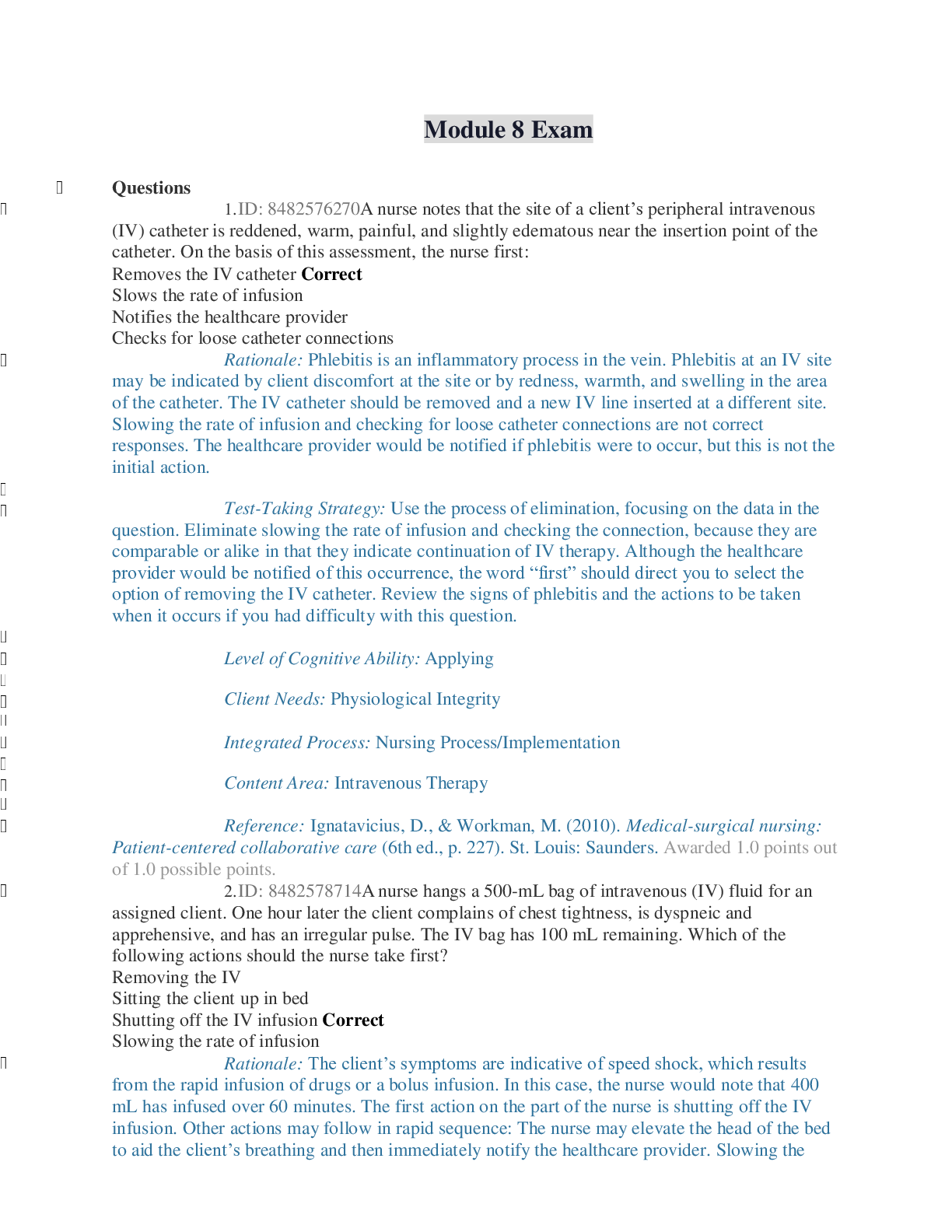
Buy this document to get the full access instantly
Instant Download Access after purchase
Add to cartInstant download
Also available in bundle (1)
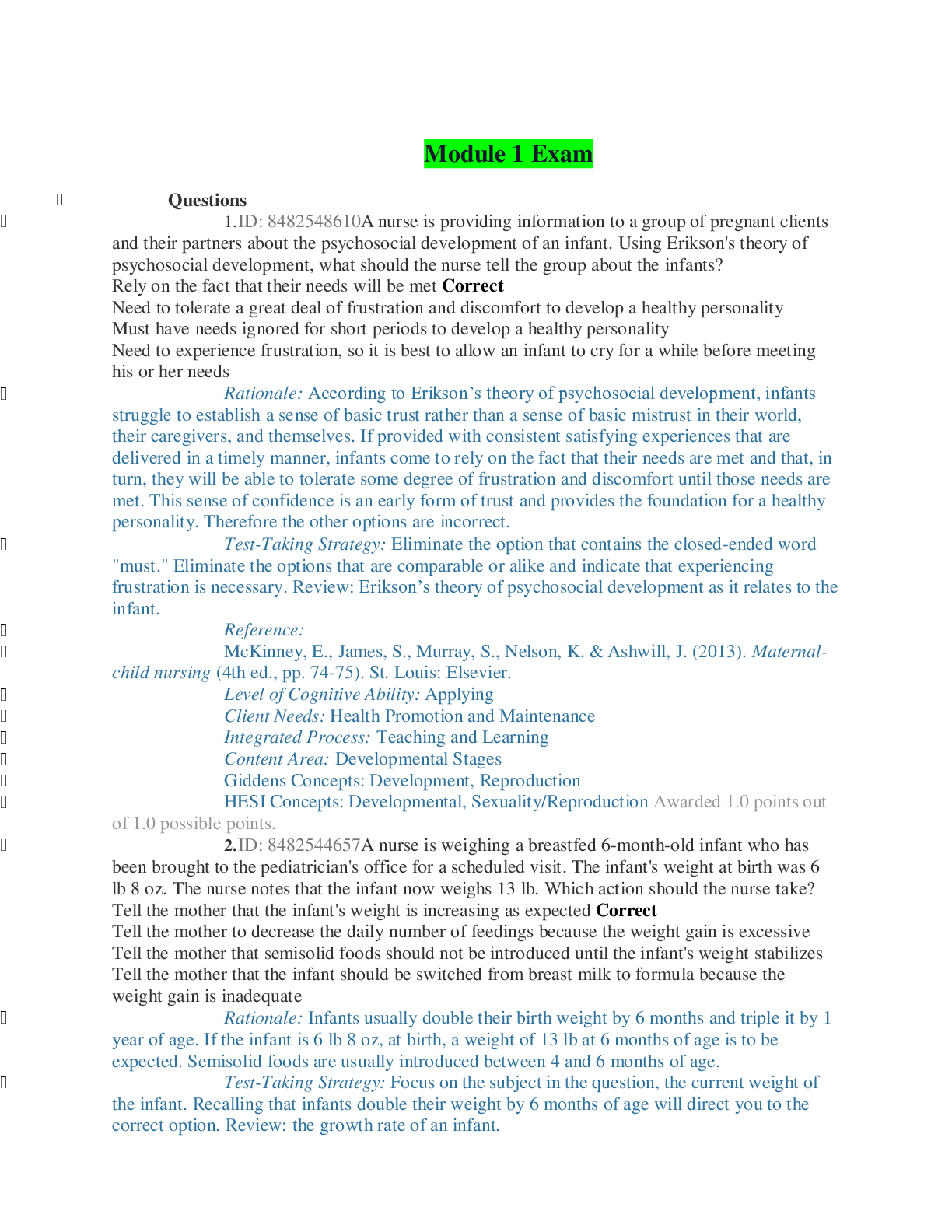
NURSING 2362 - Module 1,3,4,5,6,7,8,9,&10 Exams (Questions & Answers)
Module 1 Exam|Module 3 Exam|Module 4 Exam|Module 5 Exam|Module 6 Exam|Module 7 Exam|Module 8 Exam|Module 9 Exam|Module 10 Exam
By Ajay25 3 years ago
$75
9
Reviews( 0 )
Document information
Connected school, study & course
About the document
Uploaded On
May 28, 2021
Number of pages
65
Written in
Additional information
This document has been written for:
Uploaded
May 28, 2021
Downloads
0
Views
54


